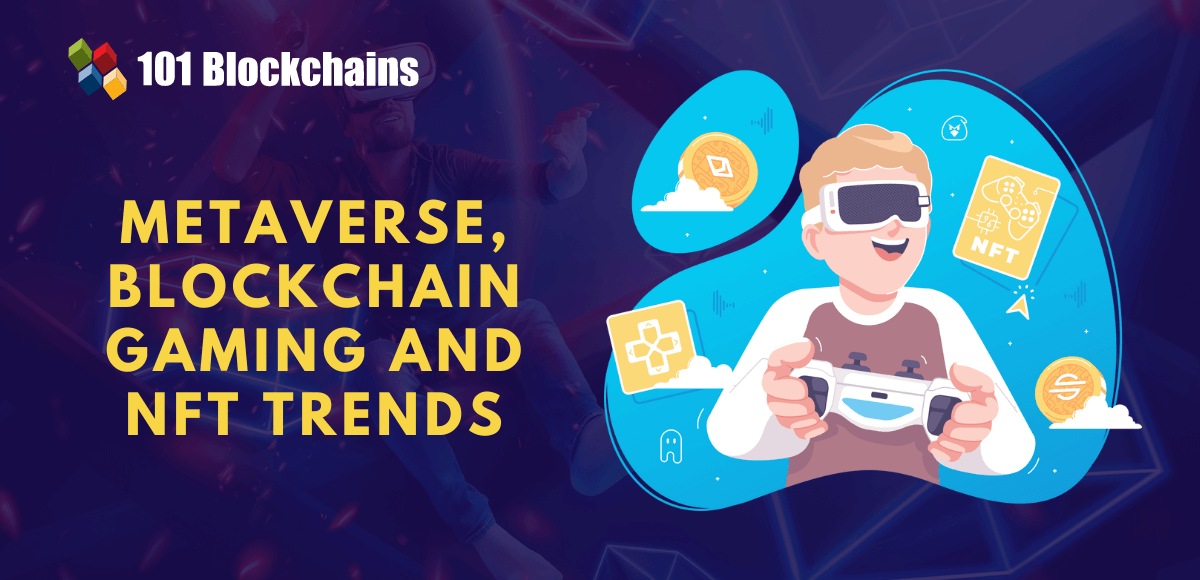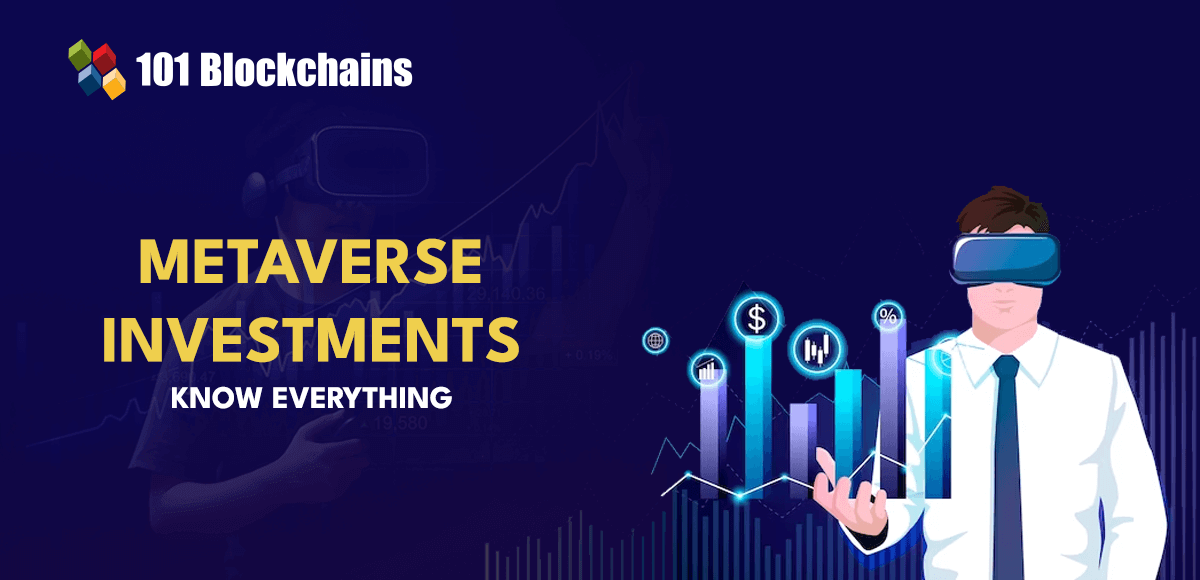Learn how blockchain truly works, master key definitions, and uncover what makes smart contracts so "smart." Dive into the fundamentals, gain valuable insights, and start your blockchain journey today!

Metaverse
James Howell
on February 02, 2022
Metaverse Technology – A Definitive Guide
What is Metaverse? How will metaverse shape up the future? Let’s dive into the definitive guide of Metaverse technology.
Connectivity is one of the most prominent benefits we have drawn from the use of technology over the years. Today, people all over the world are connected with each other through smartphones, tablets, laptops, and personal computers connected to the internet. There was a time when the internet was all about pages where you could only view information on web pages.
Now, you can create content and share it on different social media platforms and many online virtual communities. The Metaverse technology is all set to take us into the next stage of the internet, where you can explore the internet as an open virtual environment. Many people have developed a basic impression of how the metaverse would like- a digital counterpart or mirror image of the real world in virtual spaces.
How relevant are the assumptions about metaverse technologies? What exactly is the metaverse? How will the metaverse shape up in the future? You can find the answers to all these questions by taking a deep dive into the fundamentals of the metaverse. The following discussion provides you with an overview of the fundamentals of the metaverse and the technologies that would drive its development. You can learn about the essential traits infused by different technologies in the metaverse alongside reflecting on some top examples.
Aspiring to Become a Certified Metaverse Expert? Enroll in Certified Metaverse Professional (CMP) Certification Course Now!
What is Metaverse Technology?
The foremost concern on anyone’s mind regarding the metaverse technology would be its definition. What is the metaverse? You can encounter many definitions of the metaverse, which may end up confusing you. On the contrary, you must settle for a commonly accepted definition of the metaverse. The metaverse is a large, open, shared, and persistent 3D virtual world where users can explore and interact with each other through their digital avatars. The metaverse also allows the scope for performing many complex interactions.
Although the answer for “what is metaverse technology?” gives a favorable impression of what it can possibly be, it does not shed light on its origins. Where did the idea of a metaverse come from? The origins of the metaverse go back to 1992, when a science fiction novel author, Neal Stephenson, coined the term for the first time in his book Snow Crash. If you look at the definition of a metaverse in Stephenson’s novel, you will find many similarities with the proposed vision for the metaverse.
Uses of Metaverse
The second most important concern in discussions related to the metaverse obviously draws attention towards metaverse technology use cases in the real world. People seeking knowledge about the metaverse would look for the possible ways in which the metaverse can find applications in the real world.
As of now, you will find that the applications of metaverse technologies revolve around open-world games and virtual experiences. However, the metaverse is capable of a lot more than that, and the wide range of potential use cases can define the future possibilities for its growth. Here are some of the promising applications of the metaverse which tech experts believe will drive the growth of metaverse.
- Non-competitive social interactions in virtual environments other than mission-oriented games.
- Activities and functionalities in three-dimensional virtual worlds mirror the real world.
- Virtual economies are associated with the real world while enabling people to work on developing virtual stocks, NFTs, goods, and others.
- Advanced simulations with the incorporation of improved VR and AR technology alongside other hardware to drive metaverse applications.
- Extended support for virtual assets, experiences, and environments created by users.
The various possible uses of metaverse obviously call for the use of the best metaverse technology to achieve faster growth in this domain. However, it is important to know how you can fit the different technologies together in a coordinated framework. This is where you need a clear overview of the architecture of the metaverse.
Want to get an in-depth understanding of metaverse concepts? Join Standard/Premium Plan and get free access to Metaverse Fundamentals Course Now!
Components in the Metaverse

Please include attribution to staging2.staging2.101blockchains.com with this graphic. <a href='https://staging2.staging2.101blockchains.com/blockchain-infographics/'> <img src='https://staging2.staging2.101blockchains.com/wp-content/uploads/2022/02/Components-in-the-Metaverse.png' alt='Components in the Metaverse='0' /> </a>
You can develop a clear impression of various prominent metaverse technologies by taking a look at how the components of a metaverse work in unison. When you think of the metaverse, you cannot just imagine a huge virtual world. On the contrary, you must look at the different components which serve as metaverse technology components. Here is an outline of the different components associated with the metaverse.
-
Infrastructure
Any technology solution or platform cannot work without the desired infrastructure for backing them. The infrastructure for the metaverse would largely focus on connectivity technologies such as cloud computing, Wi-Fi connectivity, and computing resources.
-
Interface
The next crucial aspect for bringing metaverse technology use cases closer to users would be the interface. How will users join the metaverse? Interface technologies such as VR headsets, haptics, AR glasses, and many other technologies help users in joining the metaverse.
-
Decentralization
Decentralization is one of the biggest metaverse components you would need for building the open and shared metaverse. Various metaverse technology examples show how you can openly access and move freely within the metaverse. There is no centralized entity controlling the metaverse, and decentralization is the essential component required for the same. The metaverse technologies which facilitate decentralization include blockchain, edge computing, artificial intelligence, and other tools tailored for democratization.
Build your identity as a certified blockchain expert with 101 Blockchains’ Blockchain Certifications designed to provide enhanced career prospects.
-
Spatial Computing
Interactions with three-dimensional virtual worlds can be quite difficult without spatial computing. Therefore, you would definitely need spatial computing technologies such as 3D visualization and modeling tools. The spatial computing tools are crucial for developing immersive experiences, which will be the primary highlights of the metaverse.
-
Creator Economy
Another important highlight you can notice in metaverse technology use cases would refer to the creation of independent economies. Every metaverse platform needs a creator economy so that it can enable the free and unrestricted exchange of value within the metaverse ecosystem. The most critical aspects in a creator economy would focus largely on a collection of design tools, e-commerce establishments, and digital assets.
-
Discovery
You must have found out how the metaverse technology is basically a new and open 3D version of the internet. The metaverse also needs tools that can guide users to wherever they want. So, you would come across the necessity of the ‘Discovery’ element in the metaverse components. The ‘Discovery’ component of the metaverse primarily focuses on the content engine for fuelling engagement. At the same time, it also encompasses social media, reviews, advertisements, ratings, and other user experience elements in the conventional web.
-
Experiences
The final component in the metaverse draws attention to the massive potential of metaverse technologies. Experiences drive one of the significant factors in the metaverse by enabling VR equivalents of different digital apps. You can interact with friends on social media in 3D and work in immersive workplaces through metaverse-enabled experiences.
Based on an impression of the different components of the metaverse, you can develop the foundation to understand different technologies powering the metaverse.
Want to learn Metaverse concepts quickly? Check out Now Metaverse Flashcards and Metaverse FAQs
Technologies behind the Metaverse

Please include attribution to staging2.staging2.101blockchains.com with this graphic. <a href='https://staging2.staging2.101blockchains.com/blockchain-infographics/'> <img src='https://staging2.staging2.101blockchains.com/wp-content/uploads/2022/02/Technologies-behind-the-Metaverse.png' alt='Technologies behind the Metaverse='0' /> </a>
Despite the unparalleled excitement surrounding the metaverse, it is still far from reality. On the other hand, identification of the best metaverse technology can provide insights on how the metaverse will develop in the future. What are the technologies driving seamless interactions in the metaverse? How can users engage with different applications in the metaverse? You can find the answer to these questions by taking a look at the prominent technologies underlying the development of metaverse.
-
Blockchain
Blockchain and crypto are undoubtedly the two most crucial metaverse technologies for shaping up the digital counterpart of or real world. You can get a decentralized and transparent solution for verified digital proof of ownership through blockchain technology. On the other hand, crypto could help users in transferring value in their different activities and interactions in the metaverse. For example, users can purchase virtual land parcels in the Decentraland metaverse by using the native token. Most important of all, crypto could serve as a potential incentive for contributions to the metaverse.
Learn about the fundamentals of blockchain technology through Blockchain Fundamentals Presentation
-
Augmented Reality and Virtual Reality
AR and VR are the two most prominent technologies tailored for offering engaging and immersive 3D experiences in the metaverse. Most important of all, they are the mandatory requirements in metaverse technology examples for accessing the virtual worlds. However, many people are still confused about the implications of AR and VR for the metaverse.
Augmented reality leverages digital visual elements alongside characters for morphing the real world. You can easily access AR through any smartphone or digital device featuring a camera. AR applications enable people to view their surroundings with interactive visuals. On the other hand, virtual reality or VR is a completely different game. It creates computer-generated virtual environments which users can access through VR headsets, sensors, and gloves. As both AR and VR continue to mature, their applications in metaverse technology use cases will become more mainstream.
-
Artificial Intelligence
The next entry among metaverse technologies would refer to artificial intelligence or AI. Artificial intelligence has found many promising applications in our lives in the last few years. AI has opened up new avenues in strategy planning, insights-based decision making, efficient computing, facial recognition, and many other tasks. The discussions around using AI for creating highly engaging metaverse platforms have also been gaining attention in recent times.
For example, AI can serve as a unique tool for driving responsive functionalities from non-player characters in the metaverse. In addition, AI can also serve as the best metaverse technology for facilitating the creation of metaverse avatars. AI engines can analyze images or three-dimensional scans for generating realistic avatars with different expressions, clothes, and traits.
-
Internet of Things
Internet of Things or IoT is also an unavoidable metaverse technology as it bridges the gap between the real and virtual worlds. IoT connects medical devices, thermostats, cameras, voice-activated speakers, and many other devices to a massive variety of data. The applications of IoT in the metaverse would largely focus on collecting and providing data from the physical world. As a result, the incorporation of IoT can drive improved accuracy of digital representations in the metaverse. Furthermore, the connection with real-life devices provides better prospects for real-time simulations in the metaverse with IoT.
Want to familiarize yourself with the technology stack associated with IoT? Enroll Now in Internet Of Things (IoT) – Intermediate Level Course!
-
3D Reconstruction
Even if 3D reconstruction is not new among metaverse technologies, it has become quite popular in the real estate industry. As virtual real estate tours started gaining traction, many agencies turned towards 3D reconstruction for offering virtual property tours. Buyers can take a tour around the new properties from any location in the world and make their decisions accordingly. 3D reconstruction will play a vital role in creating a metaverse that is almost as realistic and natural as the real world.
Examples of Metaverse Technology
The most interesting way to understand metaverse technologies would be a clear overview of the real use cases. Here are some of the notable examples which showcase favorable prospects for the long-term growth of the metaverse.
-
Decentraland
Decentraland is an open metaverse platform that offers virtual parcels of land for sale. Founded in 2017, the Decentraland metaverse has become quite popular in recent times for virtual real estate auctions.
-
Sandbox
Another prominent entry among metaverse technology examples refers to Sandbox, a pioneer in metaverse games. Users can discover parcels of virtual land in the Sandbox platform and the tools for creating in-game assets and experiences.
-
Second Life
You could also gain a clear impression of the potential of metaverse technologies by taking note of examples like Second Life. It showcases how the metaverse would evolve over the course of time by bringing in many other communities on board. The most striking highlight of Second Life is the ability for users to create customizable avatars without any restrictions.
Want to become metaverse expert? Checkout detailed guide on How To Become Metaverse Developer
Bottom Line
The different examples of metaverse technologies in the real world and their applications show favorable future prospects for the metaverse. However, the individual growth of each component in the metaverse will strengthen the opportunities for the metaverse. For example, the development of AR and VR-based experiences in the metaverse alone would not empower its future.
On the contrary, developers have to focus on decentralization, experiences, creator economy, and connectivity technologies required for developing the metaverse. As big companies enter the metaverse field every day, the race for building an operational metaverse is underway. Learn more about the metaverse and how it can change the future.
*Disclaimer: The article should not be taken as, and is not intended to provide any investment advice. Claims made in this article do not constitute investment advice and should not be taken as such. 101 Blockchains shall not be responsible for any loss sustained by any person who relies on this article. Do your own research!





